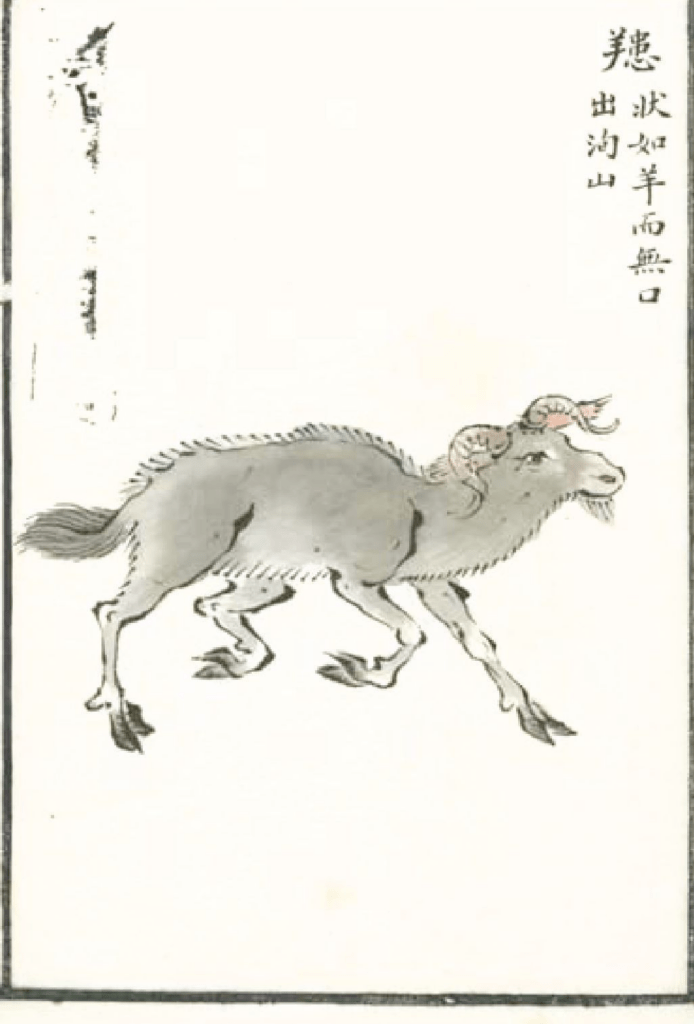Qian Yang/羬羊

羬羊 (Qian yang) is a beast on the mountain that looks like a sheep, but has a horse’s tail. The oil from its fat can be used to treat chapped skin.
《山海经·西山经》
华山之首,曰钱来之山,其上多松,其下多洗石。有兽焉,其状如羊而马尾,名曰羬羊,其脂可以已腊。
In the rich tapestry of Eastern folklore, the introduction of Chinese Yokai, known as Yaoguai(妖怪), weaves a distinct narrative when compared to their Japanese counterparts, the Yokai. While sharing a semblance in their supernatural essence, these entities diverge in several intriguing facets.
Linguistically, the disparity lies in the terms themselves: “Yokai” denotes an enigmatic apparition in Japan, while “Yaoguai” embodies an enticing demon in China.
Visually, the contrast is stark; Japanese Yokai exhibit whimsical, often cartoonish forms, while Chinese Yaoguai adopt a more somber, realistic guise and are often associated with human possession. Culturally, Yokai are entrenched in Japanese society, familiar to many, while Yaoguai’s presence remains less widespread beyond China’s borders.
Moreover, their roles diverge; Yokai lean towards mischievousness but benign intent, even offering protection, whereas Yaoguai are perceived as malevolent, posing threats to human safety.
Within these distinctions lies a tapestry of supernatural lore, highlighting the nuanced variations between these captivating entities in their respective cultural landscapes.

羬羊 (Qian yang) is a beast on the mountain that looks like a sheep, but has a horse’s tail. The oil from its fat can be used to treat chapped skin.
《山海经·西山经》
华山之首,曰钱来之山,其上多松,其下多洗石。有兽焉,其状如羊而马尾,名曰羬羊,其脂可以已腊。
In the west of the Zhang family house on Jingling’s Judicial Street(金陵評事街), there were three study rooms rumored to house a hanging ghost. No one dared to live there; it remained securely locked. One day, a young scholar, dressed in fine attire, arrived seeking lodging at the Zhang household. The Zhang family, citing the lack of available rooms, refused him. The scholar, angered, said, ‘If you won’t lend me a room, I’ll stay on my own.
Li Yi(李鷁), the son of Minister Li Hefeng(李鶴峰), styled as Yishan(醫山), passed the imperial examination in the 26th year of Qianlong’s reign and was selected to join the Hanlin Academy(翰林). He excelled in poetry and literature, and had a fondness for the Cheng-Zhu school of Neo-Confucianism(宋儒理學).
One day, while Li Yi was studying under the lamp, two exceedingly beautiful women suddenly appeared to tempt him, but he paid them no attention.
In the Baihou(白鱟) Cave of Mount Bian in Wuxing(吳興卞山), every spring and summer, a white vapor drifted out of the cave. It resembled a piece of white silk, floating aimlessly in the air. Wherever this vapor passed, silkworm cocoons were destroyed completely. Hence, during silkworm cultivation, people dreaded this white vapor. However, this vapor was particularly afraid of the sound of gongs and drums. During the Ming Dynasty, Han Shao(韓紹), the Minister of Rites(明太常卿), once ordered officials to use poisoned arrows to drive it away, documenting the process in the ‘Expulsion of the White Sea Hare’ found in the ‘Annals of Wuxing Prefecture.'(《驅鱟文》載郡志)
During his tenure as the magistrate of Liangdang County(兩當縣) in Shaanxi(陝西), Tu Chiwen(屠赤文) had a cook named Zhang(張某) under his command. Zhang, a powerful and hearty eater, possessed immense strength and a robust stature but lacked his left ear. Tu Chiwen inquired about the cause of his missing ear, and Zhang recounted his experience.
“I hail from Sichuan(四川), where my family for three generations lived off hunting. We owned an extraordinary book passed down through generations, teaching hunters a peculiar skill: by catching a breeze and sniffing it, one could discern the approach of any wild beast.
According to the ancient texts: ‘Those with green pupils can see demons; those with white pupils can see ghosts.’
Next to the stone archway of Sanyuan Fang(三元坊) in Hangzhou lived an old lady surnamed Shen. She could often see ghosts. She once said, ‘Ten years ago, I saw a disheveled ghost hiding in the stone embroidery on top of the archway. It held paper money, using it as a dart. The paper dart was over ten feet long, densely packed, resembling a string of beads.
In Ding Shuiqiao(丁水橋), a town in Tangxi(塘西鎮), Zhejiang(浙江), there was a boatman named Ma Nanzhen(馬南箴). One night, he was paddling a small boat on the river. On the shore, there was an old lady with her daughter, signaling the boat, requesting passage. Several passengers on the boat advised Ma Nanzhen to ignore her and refuse to ferry the old lady. However, Ma Nanzhen said, ‘It’s late at night, and they are women without a place to stay.
Yang Kaxiong(楊喀雄)’s father served as a military officer but passed away early. His paternal uncle, Zhou, held the position of deputy general, stationed in Hezhou(河州). Feeling sympathetic for the young and orphaned Yang Kaxiong, he took him in and raised him. Zhou had a daughter who took a liking to the young and clever Kaxiong. She often gave him food. Despite their closeness, there was no impropriety between Zhou’s daughter and Kaxiong.

In the mountains, there is a beast called Zhi(彘). It looks like a tiger, has a tail like a cow, and barks like a dog. It eats people.
有獸焉,其狀如虎而牛尾,其音如吠犬,其名曰彘,是食人。
《山海經 南次二經》

The Huan(䍺)’s shape is like a sheep’s, it has no mouth, but it will not starve.
又東四百裏,曰洵山,其陽多金,其陰多玉。有獸焉,其狀如羊而無口,不可殺也,其名曰䍺。
《山海經 南次二經》
In Huizhou(徽州), there was a top scholar named Dai Youqi(戴有祺). He and his friends, having drunk too much, strolled outside the city to admire the moon, reaching the Hui Long Bridge(回龍橋). A person in blue, carrying an umbrella, approached from the west side. Upon seeing Dai, he hesitated to cross the bridge, appearing fearful. Suspecting him to be a thief, Dai stepped forward to interrogate him. The person in blue claimed, ‘I am an officer from the yamen, sent to apprehend someone.’